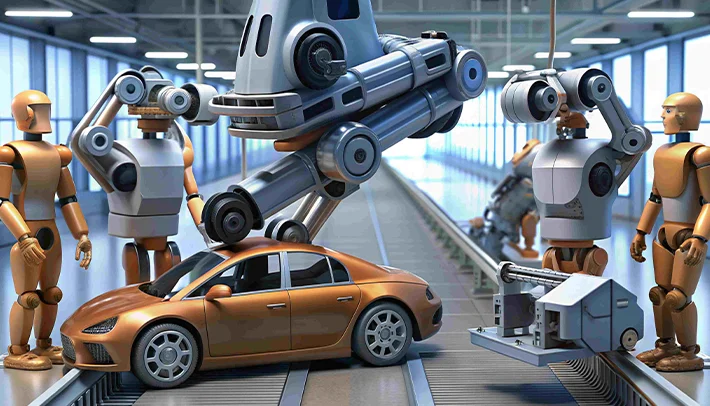From Robotics to Autonomous Vehicles: Engineering the Future of Mobility

It starts with a traffic jam. Not the kind that frustrates you during your daily commute, but the kind that sparks curiosity. Why do cars stop when there’s no visible cause? Why can’t vehicles talk to each other? Why does a two-ton machine still rely entirely on human reflexes?
These are not questions one asks in design schools or research studies. They are asked by budding engineers who look at a road and not just a surface to travel on, but a system to be revolutionized.
Today, the border between robotics and transport is fading. Cars are learning to see, make decisions and adjust. The future of mobility is not merely fast. It is smart, sensitive and heavily engineered.
Let's lift the hood and see how robotics is pushing us into the age of autonomous mobility.
1. Robots on Wheels: The New Age of Mobility
Fundamentally, an autonomous car is a robot. A highly sophisticated one. It interacts with the world by means of sensors, cameras and control systems. It computes on the fly. It reacts to the world without the direct intervention of a human.
- Lidars, radar and ultrasonics are sensors that enable vehicles to sense their environment
- Computer vision software enables them to identify lanes, pedestrians and traffic signals
- Steering, acceleration and braking are controlled by actuators and control units in a robotic mind-body loop
This is not transporting. This is robotics on a larger level. Every action of a self-driving car demonstrates precision and coordination like in high-end robotic systems.
2. Coding the Compass: Decision-Making in Motion
Actual magic is not in movement but in judgment. Vehicles have to make decisions, and they have to do it quickly.
- Path planning algorithms create the optimal route in real-time
- Machine learning models enable the system to learn from experience
- Sensor fusion methods blend multiple sources into a single solid interpretation of the world
All of this in a fraction of a second. One instant, the car notices a kid dash into the street. The next, it has already reacted. This combination of speed and security is a success of robotic smarts brought to motion.
3. Collaboration on the Road: Cars that Talk
The future of mobility isn't solely about individual smart cars. It is about systems. Roads in which all the cars, traffic lights and signs are on a common network.
- Vehicle-to-vehicle communication prevents accidents
- Vehicle-to-infrastructure systems optimize traffic based on real-time information
- Cloud-based updates keep vehicles updated with new maps and regulations
This is mobility that thinks as one. A city where traffic responds like a living entity, influenced by information and interaction.
4. Testing Grounds: Where Engineering Meets Reality
Theoretical models are just the beginning. All innovation in autonomous mobility needs to be tested in the real world.
- Simulations try out cars in thousands of virtual environments
- Controlled tracks imitate tough road conditions
- Urban pilots assist systems in learning from actual city conditions
Each bump, each curve and each unexpected pedestrian is a learning opportunity. Robotics engineers approach the road as a laboratory, and each mile on the road is an experiment.
5. Challenges that Define the Journey
This journey is far from smooth. Engineering the future of mobility involves hard questions.
- How do we provide safety and reliability in uncertain environments?
- How do we deal with ethical choices in emergency scenarios?
- How do we make systems that are usable and accessible by all users?
These are not second-order issues. They are fundamental ones. And they are influencing the way robotic systems develop for transport.
6. Mobility for All: Engineering with Purpose
Self-driving mobility is not a matter of convenience or speed. It is a matter of access. It is a matter of individuals who cannot drive regaining autonomy. It is a matter of lowering accidents, enhancing traffic and reducing emissions.
- Autonomous shuttles transport senior citizens and individuals with disabilities
- Electric autonomous cars shrink the carbon footprint of daily travel
- Shared autonomous fleets can deliver lower costs and greater reach
This is mobility that benefits. It's engineering not for technology's sake, but for human's actual needs.
The Journey Ahead
The future path is still being mapped out. It has corners, curves and a lot of unknowns. But what makes it thrilling is the sheer mashup of disciplines converging. Mechanics, electronics, data science, ethics and urban design. It is an entire knowledge ecosystem converging in one direction.
From first robotic arms on factory floors to cars that drive themselves through cities, the journey has been consistent and breathtaking.
And with each innovation, something is certain: the future of mobility is not so much where we are headed, but how we get there. Carefully. Intelligently. Responsibly.
The road is no longer silent. It listens. It learns. And it just might drive your home.